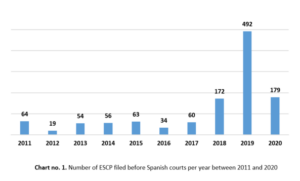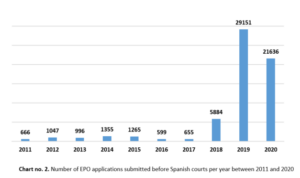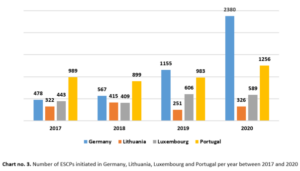
Willem 1, Buddhist mummy. Statue (L), CT scan (R). (Photos: Drents Museum)
by Zhen Chen, PhD researcher in the Department of Private International Law, University of Groningen, the Netherlands (ORCID ID: https://orcid.org/0000-0001-5323-4271)[1]
In Buddha Mummy Statue case, the Chinese village committees sued the Dutch defendants for the return of a stolen golden statue which contains a 1000-year old mummified buddhist. The parties had different opinions on the legal nature of the mummy contained in the statue. The Chinese court classified the statue as a cultural property and applied the choice of law over movable properties provided in Article 37 of Chinese Private International Law (lex rei sitae). Based on a comparative study, this article argues that a mummy does not fall within the traditional dichotomy between a person and a property. Instead, a mummy should be classified as a transitional existence between a person and a property. If the classification of a mummy has to be confined to the traditional dichotomy, a mummy can be regarded as a quasi-person, or a special kind of property. Following this new classification, a new choice of law rule should be established. In this regard, the Belgian Private International Law Act, which adopts the lex originis rule supplement by the lex rei sitae, is a forerunner. This article advocates that the adoption of the lex originis rule may help to stop the vicious circle of illegal possession and to facilitate the return of stolen cultural objects, especially those containing human remains, to their country of origin.
1. Gold or God?
As to the legal nature of the Buddha Mummy Statue in dispute, from the Chinese villagers’ perspective, the mummy contained in the golden statute is a person or God, instead of a property. Specifically, the mummified buddhist Master Zhanggong was their ancestor, who used to live in their village and has been worshipped as their spiritual and religious God for over 1000 years. Master Zhanggong was preserved in a statue moulded with gold to prevent decomposition and to maintain his immortality. The villagers celebrated Master Zhanggong’s birthday every year with feast, music and dance performance, which has become their collective memory and shared belief.
In contrast, from the Dutch art collector’ perspective, the golden statute containing a mummy is a property not a person. It is merely a cultural property with great economic value and worthy of collection or investment. Thus, it is not surprising that the Dutch collector asked for a compensation of 20 million Euro, of which the Chinese villagers whose annual income was around 1000 Euro could not afford it.
The Chinese village committees sued the Dutch art collector both in China and in the Netherlands. The Chinese village committees asserted that the mummified Master Zhanggong contained in the statue was a corpse within the meaning of the Dutch Liability Decree, and the ownership thereof was excluded under the Dutch law.[2] The claimants as the trustees or the agents had the right of disposal.[3] The Dutch art collector argued that the mummified monk contained in the golden statue was not a corpse, as the organs of the monk were missing. The Dutch court did not touch upon the issue of classification of the Buddha Mummy Statue, as the case was dismissed on the basis that the Chinese village committees had no legal standing nor legal personality in the legal proceedings.[4]
2. The lex situs under Article 37 Chinese Private International Law Act
The Chinese court classified the Buddha Mummy Statue as a cultural property and applied the law of the country where the theft occurred, namely Chinese law, by virtue of Article 37 Chinese Private International Law Act. Such classification is not satisfactory, as the mummy in dispute was essentially considered as a property. Chinese law was applied because the place of theft was in China and the lex situs was construed by the Chinese court as the lex furti. However, what if the mummy was stolen in a third country during the transportation or an exhibition? The lex furti does not necessarily happen to be the lex originis in all cases involving stolen cultural objects.
Moreover, cultural objects containing human remains are special in comparison with other cultural objects without, as human remains contain biological information of a person. The application of the traditional lex rei sitae rule to all cultural objects, including those containing human remains, is far from satisfactory. In general, the law on dead human bodies precedes over the sale of corpses, and no person, including a good faith purchaser can own somebody else’s corpse both in civil law and common law systems.[5] A corpse must not be downgraded to the status of a property.[6] The characterization of human remains as properties objectifies human remains and thus may violate human dignity.[7] Therefore, it is necessary to distinguish cultural objects containing human remains from other types of cultural objects. The question is how to draw a distinction and what is the legal nature of a cultural object containing human remains, such as a mummy. If a mummy does not fall within the scope of traditional category of a person nor a property, does it mean a new category need to be created? In this regard, the classification of the legal nature of a fertilized embryo in Shen v. Liu may be relevant,[8] since the judge addressed the issue by thinking out of the box and provided a new solution.
3. Is a Fertilized Embryo a Property or a Person?
Shen v. Liu was the first case in China that involved the ownership of frozen embryos. Specifically, Shen and Liu, who got married in 2010 and died in 2013 in a car accident, left four frozen fertilized embryos in a local hospital. The parents of Shen (Mr and Mrs Shen), sued the parents of Liu (Mr and Mrs Liu), who also lost their only child, claiming the inheritance of the four frozen fertilized embryos of the deceased young couple.[9] The local hospital where the embryos were preserved was a third party in this case.
3.1 A property, a special property, or ‘a transitional existence between person and property’?
The third party Gulou Hospital argued that the frozen embryos do not have the nature of a property. Since Mr. and Mrs. Shen had passed away, the expired embryos should be discarded. Neither the plaintiffs nor the defendants should inherit the embryos.[10] The first-instance court held that fertilized embryos had the potential to develop into life, and thus are special properties that contain biological characteristics of a future life. Unlike normal properties, fertilized embryos can not be the subject of succession, nor be bought or sold.[11]
Nevertheless, the appellate court took the view that embryos were ‘a transitional existence between people and properties’. Therefore, embryos have a higher moral status than non-living properties and deserve special respect and protection. The embryo ethically contains the genetic information of the two families and is closely related to the parents of the deceased couple. Emotionally speaking, the embryo carries personal rights and interests, such as the grief and spiritual comfort for the elderly. The court held that the supervision and disposal of the embryos by the parents from these two families was in line with human ethics and can also relieve the pain of bereavement for both parties.[12] Clearly, the court did not classify the fertilized embryos as people or properties. Instead, the embargo was considered as ‘a transitional existence between a person and a property’, since it is not biotic nor abiotic but a third type in-between.
3.2 A mummy as ‘a continuum between a person and a property’
With regard to the distinction between a person and a property, the judgment of Shen v. Liu shows that the Chinese court was not confined to the traditional dichotomy between a person and a property. The same should be applicable to mummies. Embryos and mummies have something in common, as they are two different kinds of life forms. Whereas the embryo in Shen v. Liu is the form of life which exists before the birth of a human being, the mummy in Buddha Mummy Statue case is another form of life which exists after the death of a human being.
Embryos and mummies, as the pre-birth transition and after-death extension of life forms of a human being, involve morality and ‘human dignity’.[13] Such transitional existence or continuum of life forms contains personal rights and interests for related parties, which may justify the adoption of a new classification. As a special form of life, embryos and mummies should not be considered as merely a property nor a person. The strict distinction between people and properties does not apply well in embryos and mummies. Instead, they should be regarded as ‘a transitional existence between a person and a property’ or ‘a continuum between a person and a property’. If it is not plausible to create a third type for the purpose of classification, they should be regarded, at least, as a quasi-person, or a special property with personal rights and interests. An embryo and a mummy cannot be owned by someone as a property. Rather, a person can be a custodian of an embryo and a mummy. This is also the reason why cultural objects containing human remains should be treated differently.
4. A New Classification Requires a New Choice of Law Rule
In order to distinguish cultural objects containing human remains from other cultural objects, or more generally to distinguish cultural properties from other properties in the field of private international law, a new choice of law rule needs to be established. In this regard, the 2004 Belgian Private International Law Act might be the forerunner and serve as a model for not only other EU countries but also non-EU countries.[14]
4.1 The lex originis overrides the lex situs
The traditional lex situs rule is based on the location of a property and does not take cultural property protection into consideration. Courts resolving cultural object disputes consistently fail to swiftly and fairly administer justice, and much of the blame can be put on the predominant lex situs rule.[15] The lex situs rule allows parties to choose more favorable countries and strongly weakens attempts to protect cultural objects.[16]
In Belgium, as a general rule, the restitution of illicitly-exported cultural objects is subject to the lex originis, rather than the lex rei sitae. Article 90 of 2004 Belgian Private International Law Act stipulated that if one object that has been recorded in a national list of cultural heritage is delivered outside this country in a way that against its law, the lawsuit filed in this country for the return of that particular object shall apply the law of the requesting country. This provision designates the law of the country of origin, also known as the lex originis rule. In comparison with the lex rei sitae or the lex furti rule, the lex originis rule is more favorable to the original owners
4.2 Facilitating the return of human remains to their country of origin
The establishment of a new choice of law rule for cultural relics containing human remains or cultural objects in general is in line with the national and international efforts of facilitating the return of stolen or illicitly cultural objects to their country of origin. Mummies exist not only in China, but also in many other countries, such as as Japan, Egypt, Germany, Hungary, USA, Russia, and Italy. The adoption of the lex originis rule could facilitate the return of stolen or illicitly exported cultural objects which contain human remains to their country of origin or culturally-affiliated place. This objective is shared in many international conventions and national legislations.
5. Concluding remarks
The mummy Master Zhanggong has not been returned to the Chinese village committees yet, since the Dutch defendants have lodged an appeal. This article argues that, in the light of the classification of frozen embryos in Shen v. Liu, mummies should be classified as ‘a transitional existence between a person and a property’. A new classification calls for a new choice of law rule. In this regard, the 2004 Belgian Private International Law Act might serve as a model, according to which the lex originis rule prevails over the traditional lex situs rule, unless the original owner chooses the application of the traditional lex situs or the lex originis rule does not provide protection to the good faith purchaser. The Chinese Private International Law should embrace such approach, since the application of the lex originis may facilitate the return of cultural relics, including but not limited to those containing human remains such as mummies, to their culturally affiliated community, ethnic or religious groups.
—
[1] This is a shortened version of the article published in the Chinese Journal of Comparative Law with open access https://doi.org/10.1093/cjcl/cxac006. Related blogposts are Buddha Mummy Statue case and Conflict of Laws of Cultural Property.
[2] Chinese Village Committees v. Oscar Van Overeem, ECLI:NL:RBAMS:2018:8919, point 3.1.
[3] Ibid.
[4] Ibid., point 4.2.5.
[5] J. Huang, ‘Protecting Non-indigenous Human Remains under Cultural Heritage Law’, 14 Chinese Journal of International Law 2015, p. 724.
[6] E.H. Ayau and H. Keeler, Injustice, Human Rights, and Intellectual Savagery, in Human Remains in Museums and Collections, DOI: https://doi.org/10.18452/19383, p. 91.
[7] Ibid.
[8] Mr and Mrs Shen v. Mr and Mrs Liu, Jiangsu Province Yixing Municipality People’s Court, (2013) Yi Min Chu Zi No 2729; Jiangsu Province Wuxi Municipality Intermediate People’s Court, (2014) Xi Min Zhong Zi No 01235.
[9] Ibid.
[10] Ibid. The third party also stated that after the embryos are taken out, the only way to keep the embryos alive is surrogacy, which is illegal in China, thus both parties have no right to dispose the embryos.
[11] Ibid. Since the first-instance court held that embryos cannot be transferred or inherited, the case was dismissed in accordance with Article 5 of the General Principle of Civil Law and Article 3 of the Inheritance Law of the PRC.
[12] Ibid. The appellate court analyzed that after the death of Shen and Liu, their parents were the only subjects and most-related parties that care about the fate of embryos. Thus, it was appropriate to rule that the parents of Shen and Liu have the right to supervise and dispose the embryos. However, such supervision and disposal should abide by the law, and must not violate public order and good morals nor infringe the interests of other people.
[13] While birth means a definite initiation into human society, death indicates a final termination of a natural person, which both involve the dignity of an individual human or even humankind. H.G. Koch, ‘The Legal Status of the Human Embryo’, in E. Hildt and D. Mieth (eds.), Vitro Fertilisation in the 1990s, Routledge 1998, p. 3.
[14] T. Szabados, ‘In Search of the Holy Grail of the Conflict of Laws of Cultural Property: Recent Trends in European Private International Law Codifications’, 27 International Journal of Cultural Property 2020, p. 335.
[15] D. Fincham, ‘How Adopting the Lex Originis Rule Can Impede the Flow of Illicit Cultural Property’, 32 Columbia Journal of Law & the Arts 2008, p.116.
[16] Ibid, p.130.



